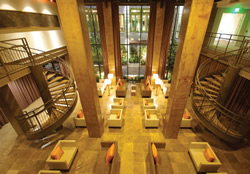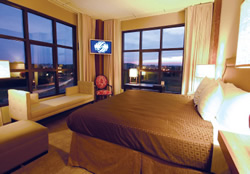by By Laurie Steiner — Most of us are guilty of it. We use a hotel towel then toss it on the floor and don’t think twice about it. You may notice a small sign sitting on the bathroom counter in your hotel room that reads: “Please help us in our efforts to help the environment. If you wish to reuse your towel, please hang it up. A towel on the floor means, please replace.” While some may disregard this notice and place it to the side making room for toiletries and such, this sign could be one of the many ways that the hotel is trying to go greener.
From the materials used to create the building to cleaning supplies and lighting throughout the facility, there are countless ways that some in today’s hotel and hospitality industry are doing their part to become more sustainable—cutting costs, saving energy and taking the hotel guest experience to a whole new level.
 |
| The Proximity Hotel lobby |
Going for the green—or platinum
Within the eco-friendly hotel, anything from the walls and windows to the carpeting and furniture could incorporate sustainability. According to the U.S. Green Building Council (USGBC), while more than 400 hotels have adopted the USGBC’s building requirements and registered to become LEED© (Leadership in Energy and Environmental Design)-certified, many are still pursuing this status.
Another certification option for hoteliers is the U.S. Environmental Protection Agency’s (EPA) ENERGY STAR© program. Currently more than 360 hotels and motels are ENERGY STAR-certified throughout the United States. According to the EPA, US$285 million could be saved if energy use was reduced by 10 percent across the hospitality industry.
Even more, there are currently 16 green lodging state programs throughout the United States—according to Green Lodging News—and more than 1,200 properties are actively participating in these programs.
“There are many reasons why hoteliers green their facilities,” said Dan Ruben, executive director of Boston Green Tourism. “Some are most interested in slashing their energy, waste disposal and water bills. Others want to satisfy the growing number of customers who want a green hotel, including corporate purchasing agents, meeting planners and individual consumers.”
To become LEED-certified, a building must earn points for certain requirements including energy use, water efficiency, materials and resources, indoor environmental quality and the innovation and design process, among others. In October 2008, the highest level of LEED certification—Platinum—was awarded to The Proximity Hotel in Greensboro, N.C., the first hotel to ever achieve such status.
Building an eco-friendly beauty
Built and operated by Quaintance-Weaver Restaurants and Hotels, the Proximity placed high importance on deciding what materials to use during the construction process. More than 40 percent of the building materials was sourced locally and 87 percent of the construction debris was recycled—eliminating more than 1,500 tons of waste from ending up in landfills. Built with materials including reinforced steel with 90 percent post-consumer recycled content and sheetrock with 100 percent, the building also includes fly ash—the mineral residue left after the combustion of coal—which diverted more than 220,000 pounds of this material from landfills.
With large energy-efficient windows throughout the facility, more than 95 percent of the hotel’s day lighting is provided by sunlight. But the sun provides much more than just the hotel’s lighting. In fact, 100 solar panels line the building’s 4,000 square foot rooftop, heating 60 percent of the water used throughout the hotel and adjoining restaurant.
“We decided to make sustainable practices a cornerstone value of our company because we’ve learned that it is true that you can do well by doing good,” said Dennis W. Quaintance, CEO and CDO of Quaintance-Weaver. “The goal posts have moved to where it is now a distinct advantage to have a sincere and real sustainable practices program. Between the dollars that you get to save and the goodwill you get to gain, it pays.”
High-efficiency Kohler plumbing fixtures—including Kohler showerheads, faucets and Cimarron Kohler toilets—allow the Proximity to significantly reduce water usage. This alone saved two million gallons of water in the hotel’s first year.
Among the facility’s many other sustainable practices, outside air is circulated throughout all guestrooms, allowing for an improved indoor air quality. Low-volatile organic compound paints and carpets also help reduce indoor air contamination.
The hotel received 90 percent of its furniture and artwork—throughout every guestroom, the spiral staircases in the lobby and the reception area—from local sources.
 |
| Quaintance-Weaver CEO and CDO Dennis W. Quaintance with solar panels on the Proximity Hotel |
An international perspective
Going green has included a variety of initiatives for one specific international hotelier. From eco-friendly pillows and recycled paper products to keycards made of recycled materials, the Marriott International continues to place sustainability at the top of its must-do list.
The hotelier has made greening its US$10 billion supply chain a key point in its environmental strategy. Among the many sustainability initiatives of Marriott International, the strategy includes creating green construction standards for its hotel developers to achieve LEED certification; reducing fuel and water usage by 25 percent per available room over the next 10 years; installing solar power at up to 40 hotels by 2017; engaging its employees and guests in going green; and helping preserve the rainforest as a means of offsetting its remaining carbon footprint.
“At Marriott, our goal is to reduce our impact on climate change through a comprehensive five-point environmental strategy,” said Stephanie Hampton, Marriott International spokesperson. “Because of our size and scale—we have more than 3,100 hotels in more than 60 countries—we can have a significant impact by making simple changes that are often transparent to our guests.”
The hotel chain recently began replacing more than 20 million plastic keycards with ones made of 50 percent recycled material. This alone saves more than 65 tons of plastic from ending up in a landfill. Even more, the hotel is replacing 100,000 synthetic pillows with those filled with polyester microfiber made from 100 percent recycled PET (polyethylene terephthalate) bottles.
Marriott International also plans for 500 of its hotels to offer coreless toilet paper by the end of 2009. This will not only eliminate two million cores per year but will save more than 100 trees and three million gallons of water.
Additionally, more than 100 Marriott, Renaissance and Courtyard hotels throughout the Middle East and Europe will purchase more than 40 tons of oxo-biodegradable plastic laundry bags which—if not recycled beforehand—will disintegrate within two to five years.
How to work together as a team
Some hoteliers may not yet have the resources to green their hotels in all of the ways that the Proximity and Marriott International have. In fact, some may simply implement a few green programs here and there to see how successful the practices become. Take for example, the Omni Parker House.
Since 1855, the Omni Parker House has been a timeless beauty in downtown Boston, Mass., and the hotel—which is the longest continually operating hotel in the United States—is now placing sustainability on its radar.
Omni Parker House Engineering Manager Bill Masefield, FMP, recently organized a green team at the hotel. The staff involved in the green team works together to implement various sustainability initiatives. Of the many ideas the team has to incorporate eco-friendly concepts, two have already come to fruition. It has instituted recycling/composting and green cleaning programs in the short time since the green team was formed.
“Greening a hotel is more than just using green products, having good energy management and recycling programs in place,” said Masefield. “Green is a culture change that starts with a dedicated team—a team that will encourage change and growth from all employees. We want our employees to see that being green is something that is easy to do both at work and at home.”
With containers on all guestroom floors, hotel guests are able to recycle glass, plastic, paper and metal. These bins are also present in all kitchens and office areas. The hotel has switched out its cleaning products with Green Seal-certified products, which not only improve the environment by reducing the use of toxic chemicals, but also increase personal health and wellbeing.
While the Omni Parker House is currently not pursuing any sort of green certification, Masefield and the green team hope that these small steps toward greening the hotel will make a large impact—not only on hotel staff and those directly involved but also on guests who may not have previously placed going green as a top priority.
 |
| A guest room at the Proximity Hotel |
Hanging up your towel
Whether your hotel has experience with sustainability programs or hasn’t quite delved into this idea just yet, the possibilities are there. Becoming a green hotel doesn’t have to include a complete remodel of your facility all at once. Take the process step-by-step. Develop a plan and organize a team to accomplish these energy-saving, cost-effective concepts together.
“Green hospitality is a trend, not a fad,”
said Ruben. “Hoteliers that stay ahead of this curve will position their facilities to attract the growing number of customers and workers that value environmentally-friendly businesses.”
Who knows—the next time you stay at a hotel, you may actually give the small sign sitting on the bathroom counter in your room a chance and think twice about whether or not you hang up your towel.
Where to begin
Believe it or not, your hotel can take its first steps down this green path too. Here are some resources to get you started.
- EcoGreenHotel.com — Visit http://www.ecogreenhotel.com/index.php to read about various green products and services, news, checklists, project ideas and more.
- ENERGY STAR for Hospitality — Visit the U.S. Environmental Protection Agency’s Web site on hospitality certification to learn how to get started, see a list of ENERGY STAR-certified hotels and motels, and access Portfolio Manager to keep track of your buildings’ energy and water use. http://www.energystar.gov/index.cfm?c=hospitality.bus_hospitality
- Green Lodging News — Read recent news, case studies and features in the green lodging industry. You can also subscribe to receive their weekly e-newsletter. http://www.greenlodgingnews.com
- Green Seal — Learn more about Green Seal’s lodging certification and find eco-friendly certified products and services. http://www.greenseal.org/
- Hotel Association of Canada — Read about the Hotel Association of Canada’s Green Key Eco-Rating Program which recognizes hoteliers committed to sustainability. http://www.hotelassociation.ca/site/programs/green_key.htm
- U.S. Green Building Council — The LEED Green Building Rating System can act as a guideline for green building development and implementation. http://www.usgbc.org/DisplayPage.aspx?CategoryID=19

Laurie Steiner is the senior associate editor of the Facility Management Journal at IFMA. She may be reached at +1-713-623-362 or via e-mail at laurie.steiner@ifma.org.